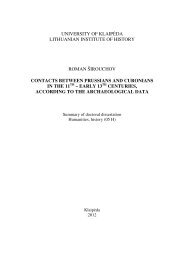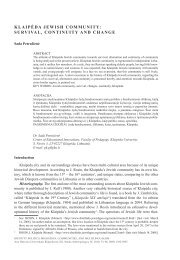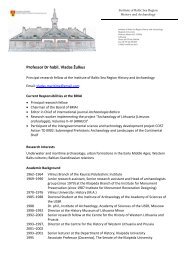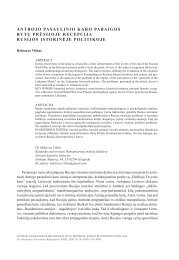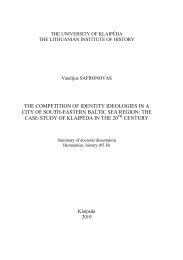See summary of dissertation in English - Baltijos regiono istorijos ir ...
See summary of dissertation in English - Baltijos regiono istorijos ir ...
See summary of dissertation in English - Baltijos regiono istorijos ir ...
You also want an ePaper? Increase the reach of your titles
YUMPU automatically turns print PDFs into web optimized ePapers that Google loves.
prevail<strong>in</strong>g op<strong>in</strong>ion <strong>in</strong> Lithuanian historiography on rather small areas<br />
<strong>of</strong> arable land <strong>in</strong> the 16 th century Samogitia.<br />
The data show that special attention should be paid to the dynamics<br />
<strong>of</strong> change <strong>in</strong> arable areas. The average number <strong>of</strong> cultivated land plots<br />
showed a decl<strong>in</strong><strong>in</strong>g tendency with<strong>in</strong> the ent<strong>ir</strong>e period under analysis.<br />
Even if it should be associated with objective factors, such as the<br />
Livonian War, epidemics, etc, it also shows the extensive character <strong>of</strong><br />
this branch <strong>of</strong> agriculture, which could have been determ<strong>in</strong>ed by other<br />
reasons as well. It should also be noted that the researchers <strong>of</strong> Polish<br />
and Livonian manorial farms recorded the same tendency <strong>in</strong> the 16 th<br />
century – f<strong>ir</strong>st half <strong>of</strong> the 17 th century as well.<br />
Apart from the four types <strong>of</strong> gra<strong>in</strong> crops – rye, wheat, barley and<br />
aot – which, as a tradition, are mentioned <strong>in</strong> the manors under<br />
analysis, pease and buckwheat cultivated <strong>in</strong> crop fields played a rather<br />
important role <strong>in</strong> Samogitia as well. On the average, 0.3 barrel <strong>of</strong><br />
pease and 1.4 barrels <strong>of</strong> buckwheat were sowed per manor. The plants<br />
grown at vegetable and fruit gardens did not play a more significant<br />
role at that time. Even though the sources <strong>in</strong>clude quite extensive<br />
<strong>in</strong>formation on them, we may presume that the products <strong>of</strong> vegetable<br />
gardens were mostly used for local needs. Among the vegetables<br />
grown <strong>in</strong> vegetable gardens, cabbages, cucumbers, carrots and<br />
parsnips were more important. Turnips and beetroots, which were<br />
particularly popular <strong>in</strong> Western Europe and played a significant role <strong>in</strong><br />
local farms at that time, were cultivated to a far lesser degree. The<br />
range <strong>of</strong> vegetables show that the vegetables <strong>of</strong> the highest nutritional<br />
value and the vegetables, which could be stored for the longest<br />
periods, were mostly preferred. Fruit gardens did not yet play a<br />
significant role <strong>in</strong> Samogitia <strong>in</strong> the 16 th century; hence, the<strong>ir</strong> numbers,<br />
sizes and agricultural value were rather trivial.<br />
Hay production was yet another important branch <strong>of</strong> crop<br />
production. It was essential to the manors, which were quite actively<br />
engaged <strong>in</strong> stock-rais<strong>in</strong>g. However, the <strong>in</strong>formation <strong>of</strong> the sources<br />
show that apart from the mentioned function, the produced hay used to<br />
be sold as well – that was also characteristic <strong>of</strong> manors <strong>in</strong> certa<strong>in</strong><br />
neighbour<strong>in</strong>g regions.<br />
30





